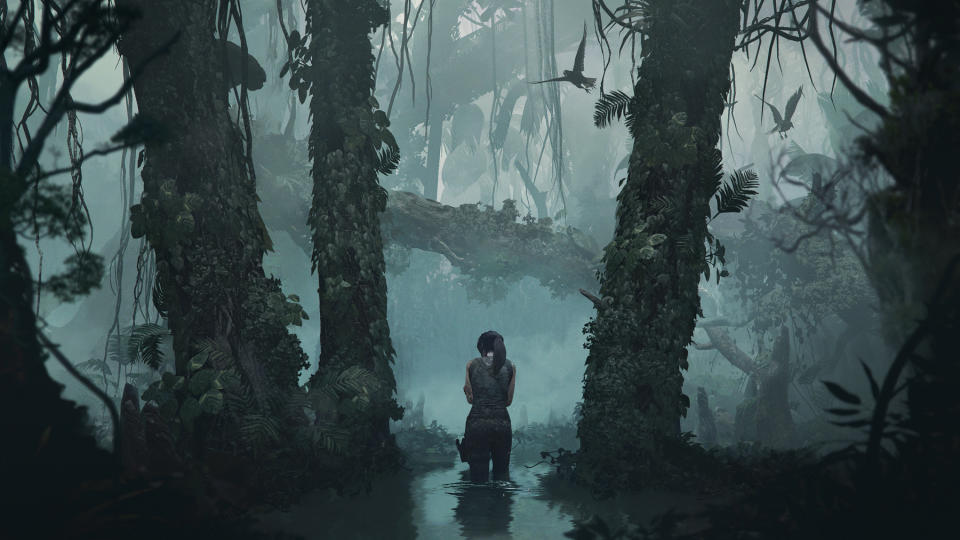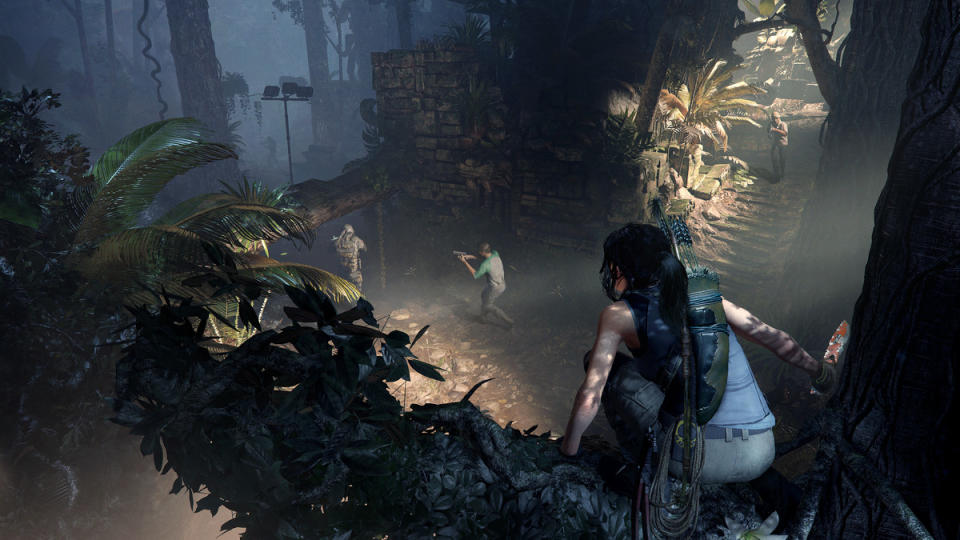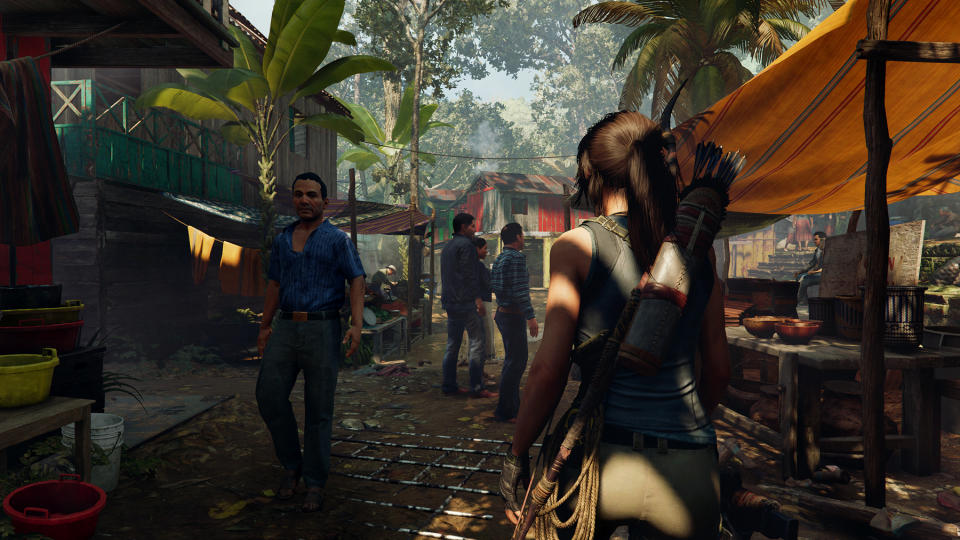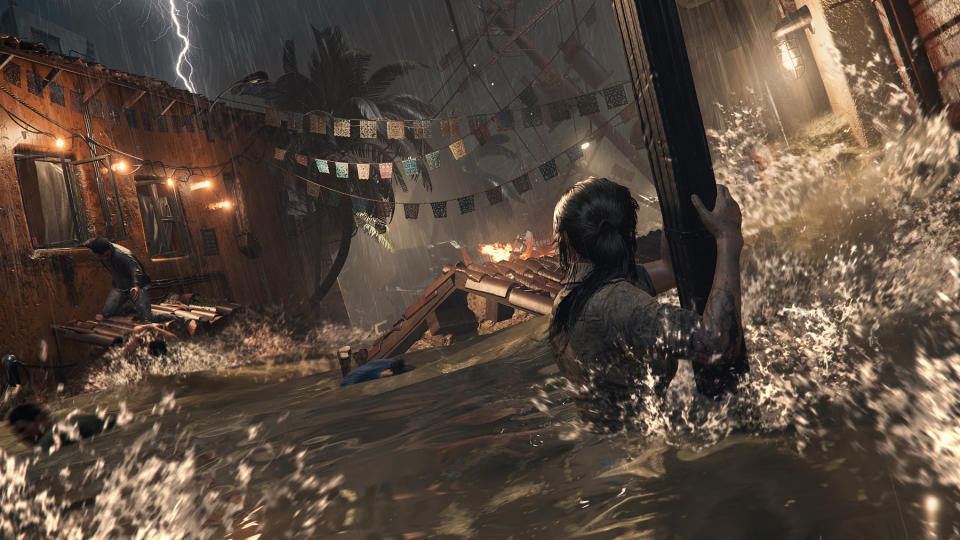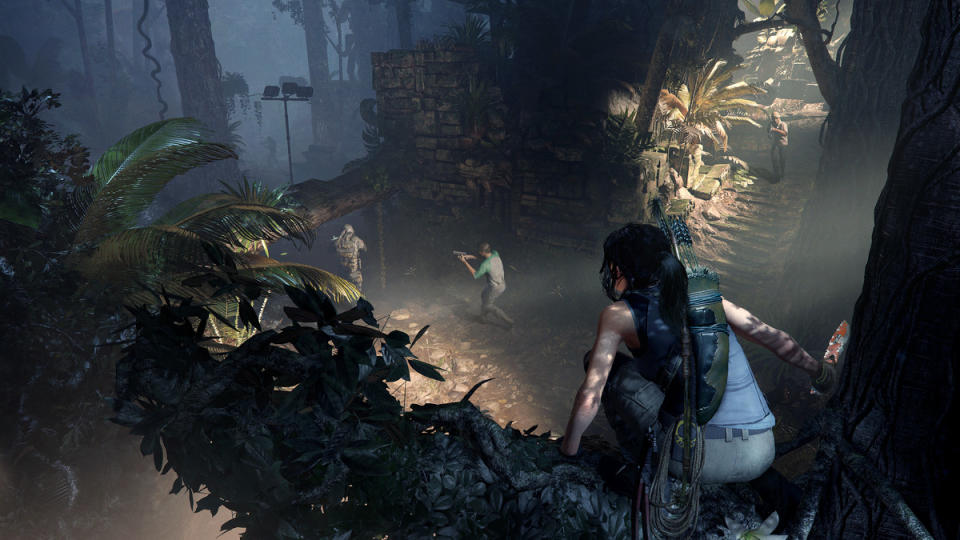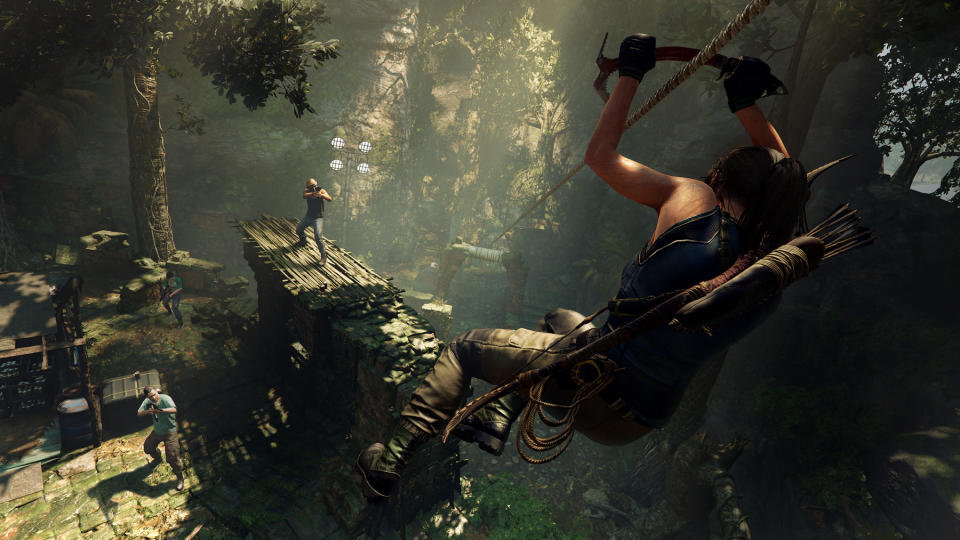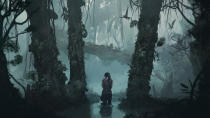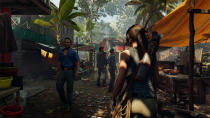Obsession drives Lara in 'Shadow of the Tomb Raider'
The opening hours explore a Croft hell-bent on beating Trinity.
Early trailers for Shadow of the Tomb Raider have portrayed Lara Croft as a ruthless killer. Someone who can hide in the jungle and silently dispatch armored soldiers with sophisticated traps and fast, calculated strikes. The underlying message is clear: The beloved archaeologist is now the hunter rather than the hunted.
Developer Eidos Montreal is framing the game as Lara's pivotal shift from reactive to proactive fighter. In 2013, when Crystal Dynamics rebooted the franchise, players were introduced to a younger, inexperienced tomb raider who had never been in a firefight before. By the end of the game, she was a capable survivor who could shoot her way out of a bad situation. The sequel, Rise of the Tomb Raider, went a step further, portraying a wiser and more resourceful explorer who could go on the offense when needed.
The third instalment, due for release on September 14th, completes her arc from naive survivor to seasoned assassin. It also explores a tomb raider who is passionate, energetic, and, on occasions, obsessive. At the start of the game, she is pinned under a large rock and injures her leg trying to break free. Lara's best friend, Jonah Maiava, asks if he can take a look at her wound, but she quickly brushes it off: "No, I'm fine." Moments later, the cavern collapses, and Jonah has to practically drag Lara away while she takes photographs with her camera.
Later, the twenty-something archaeologist tracks a Trinity henchman through Cozumel, a Mexican island celebrating the Day of the Dead. "We need to be careful," Jonah urges. Lara doesn't reply. "Lara?" "Yeah, yeah, I heard you," she whispers. The character then sneaks into a temple and, worried that Trinity henchmen are closing in, takes a fabled artifact called the "key of Chak Chel." Lara doesn't realize that it must be paired with a special box to stave off a series of apocalyptic events, though. Devastated, she watches as a tidal wave rips through the town, destroying buildings and pulling citizens underwater.
Jonah urges Lara to stay and help for a while. "These people need us here," he says. The tomb raider, though, wants to leave and find the silver box. It's a reasonable stance -- if Trinity finds both pieces, they will gain the power to reshape reality. Lara is visibly torn by the decision and later apologizes to Jonah for wanting to leave the town so swiftly.
Croft's journey from prey to predator wasn't part of some master plan in 2013. It's something that Crystal Dynamics and Eidos Montreal have developed over time. "Sometimes themes will kind of emerge," Jason Dozois, narrative director for Shadow of the Tomb Raider said. "We don't always sit down and go, 'All right, reactive to proactive, go.' I wish it was that, but it wasn't that." Shadow of the Tomb Raider is also the first game in the rebooted universe that wasn't penned by scriptwriter and story designer Rhianna Pratchett.

Rise of the Tomb Raider ended with the revelation that Lara's father, Richard Croft, was murdered by Trinity. It also proved definitively that he wasn't crazy in his search for immortality. Shadow of the Tomb Raider, then, needed to explore how Lara would process and react to this information. "Imagine you're Lara," Dozois said. "As Lara, I thought that my father committed suicide and that he was wrong. I wanted to prove him wrong [originally], and then maybe he was right? But he still committed suicide. But then it's like, OK, he didn't commit suicide?! He was murdered?!"
The previous two games have debunked everything Lara knew at the start of the 2013 reboot. "All these core bits of information that really defined who you are as a person, those are gone," Dozois said. Where does that leave her at the end of Rise of the Tomb Raider? Understandably angry, and motivated to both stop Trinity and restore her family's name.
This information contextualizes the combat in Shadow of the Tomb Raider. Gameplay alone makes Lara seem like a cold, calculated mass murderer. Within the larger story, though, the fights take on new meaning as high-tension moments of revenge. That's why many of the skirmishes are smaller in scope, too, than Rise of the Tomb Raider — it's supposed to feel more personal this time. "It's not like a shooting gallery where you have 50 guys coming in and you're like, 'All right, I need to reload!' It's more immersive and more emotional," Dozois said.

As with previous games, you'll need to be stealthy to succeed. Shadow of the Tomb Raider urges you to stay in cover and purposefully move around the map, taking out enemies as they slowly patrol the area. Alerting a soldier isn't a complete disaster, but it makes your life substantially harder. If an entire squad is looking for you, it's trickier to stay hidden and take them out like Batman.
The game has some elaborate pieces similar to Rise of the Tomb Raider. There are fewer "assault moments," though, that force you to kill large groups of enemies. "That, in a way, dehumanizes the enemy, because there are so many targets," Heath Smith, lead game designer on Shadow of the Tomb Raider said. With fewer enemies on screen, the team hopes each kill will feel more important and carry some emotional weight. "Lara has to grow up, not only emotionally in the narrative, but in her gameplay," Smith added. "That means the player has to employ more advanced techniques, such as striking, disappearing and repositioning."

An early trailer for Rise of the Tomb Raider showed Lara in a therapy session. "You say the flashbacks have stopped?" a bespectacled man asked, jotting notes on a clipboard. "This is an excellent improvement." The young adventurer looked uneasy, gripping the arms of a chair and quickly tapping her feet. Some interpreted this as a form of PTSD that would be addressed in the next game. Brian Horton, the director on Rise, quashed the theory though and said it was "anticipation to get out of the situation and just go on her adventures." Ultimately, PTSD was never explored in the game.
Shadow of the Tomb Raider takes a similar approach. According to Dozois, Croft has the opposite of PTSD: She's actively seeking out peril. Do-or-die situations are comforting to her because they provide plenty of adrenaline and clear, if physically demanding, goals. If a temple is crumbling, she needs to escape, and that means running one way, jumping a gap, holding her breath underwater, and so on. Staying still, and interacting with people, is complex by comparison. "I'm not really used to crowds," she says while walking through a Day of the Dead festival in Mexico.
In combat, Lara is rewarded for moving. Narratively, though, the game is about responsibility and stillness. Taking the key of Chak Chel was a mistake, and now she must learn how to recover and put things right. In addition, the tomb raider needs to realize that it's necessary to slow down sometimes and review the situation before taking action.

"Especially if the tomb you get to is full of people," Smith said. "Normally you run in, you take the thing and it all falls down. But if people are living there, then that's their home, right? Maybe that artifact means a lot to them, and they don't want you to take it. [The game] is about understanding what that object means, and how do you protect it, potentially, from being used in the wrong way."
Some of these ideas will be explored in the new hubs peppered throughout Shadow of the Tomb Raider. They allow Lara to converse with residents, trade resources and pick up quests that usually lead to optional challenge tombs. Stillness and responsibility are also tied to the story's McGuffin — the key and silver box. If Lara obtains both, she will gain the ability to create a new world that's theoretically free of pain and suffering. It's not the most original plot device, but it should give Croft another reason to stop and consider what's truly important.
"You're fighting against someone who wants to create a new world."
"We wanted something that would be tempting," Dozois said. "You're not fighting against someone who wants to destroy things -- you're fighting against someone who wants to create a new world." Lara begins to unpack this decision in a conversation with Jonah early in the game. "You wouldn't go back to when your brother was alive, and be with him again?" She asks. "And lose everything else? No way," Jonah replies. "I like this world. It's not perfect, but everything I love is in it."
By the end of the game, Lara will have changed yet again. She won't be a pacifist, necessarily, or best friends with Trinity. Dozois hinted, though, that the archaeologist will have found a sense of fulfillment. "For me, the end of this story and the end of this arc is hopefully moving [Lara] to a lighter place, where she's healing, getting over this obsession, getting over the pain of the loss of her family, and moving forward with her life with a bit more optimism and lightness," he explained.


